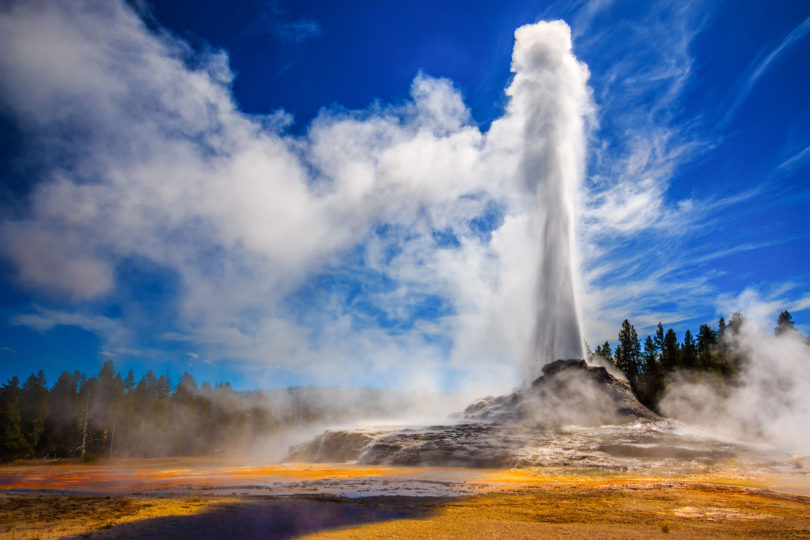America’s First National Park
Standing on Geyser Hill, a steaming pot of mud boils to your left and a jet of water suddenly spews straight up to your right. Clear pools of stunning turquoise alternate with crusty looking rust-colored rings in the dirt. You inhale, trying not to fill your lungs with the sulfurous mist that surrounds you. Despite the beauty, it’s hard not to recall descriptions of hell.
In 1807, when explorer John Colter described what would eventually become Yellowstone National Park, people mocked him. Convinced such a place was fictional, naysayers dubbed it “Colter’s Hell.” But over the next 65 years, Americans realized that not only was Yellowstone real, it was worth preserving. Congress established Yellowstone as the nation’s first national park in 1872.
Since then, people from around the world have marveled at Yellowstone’s unusual thermal features, dramatic landscape and abundant wildlife.
Thermal Features
Within its 2.2 million acres, Yellowstone has the world’s largest geyser field, laying claim to 60 percent of Earth’s geysers. Old Faithful is the most visited. It’s not the park’s biggest geyser, but it’s reliable, easily accessible and always puts on a good show.
Geysers are only one of the park’s four types of thermal features, which also include hot springs, mud pots and fumaroles. Sorry, but visitors can’t soak in Yellowstone’s hot springs. They’re too hot, and the park service is devoted to keeping them pristine. A mud pot is similar to a hot spring, but with limited water that causes boiling mud. A fumarole is an opening in the earth’s crust which spews out sulfurous gases.
Why so much thermal activity? The park actually sits atop a super-volcano with the potential to cause thousands of times as much damage as 1980’s Mount St. Helens eruption. Rest assured, it’s been 640,000 years since the last time Yellowstone blew in a major way, but scientists still watch changes in geyser activity carefully. Some visitors become so fascinated with the area’s thermal features that they join the Geyser Observation and Study Association, a 300-member citizen-science group (also called geyser gazers) that contributes many volunteer hours of tracking thermal activity.
Wildlife Viewing
Wildlife viewing is a big reason visitors flock to Yellowstone. Hikers can get close-up views of animals — sometimes too close. If you’re hiking the park, rangers urge you to stay in groups and make lots of noise. Depending on your temperament, the kiosks that rent bear spray may make you more comfortable or more anxious. Guide Steve Klug discourages trail running, which could accidentally inflame the prey drive of creatures programmed to chase anything that moves.
Fortunately for the timid, Yellowstone offers many opportunities to watch wildlife close to the road. Lamar Valley, located in the northeastern corner of the park, is one of the best spots.
In early summer, herds of bison gather by the Lamar River to eat sedges, a type of grassy looking plant. Visitors might see a mama bison nursing a red-furred baby or teaching it to swim.
Many animals aren’t as easy to spot as the bison. “You look at a lot of stumps and a lot of rocks,” says Klug, who enjoys the thrill of the hunt — for wildlife watching. “But some of them aren’t stumps and rocks.” Klug carries a spotting scope, which is like a telescope he sets on a tripod for watching animals. It’s so powerful that you can see an elk’s jaw muscles working as he chews, or a mother osprey rearranging the sticks in her nest while she sits on an egg. The spotting scope makes wildlife watching much more fun.
Sustainable Lodging
Those who prize elegance will love the Lake Yellowstone Hotel, a colonial-revival hotel built in 1891 and now an historic landmark. The oldest hotel in any national park, it was designed to lure East Coast residents to board a train to the Wyoming wilderness rather than sail to Europe for the summer. Since a 2014 renovation, the 158-room hotel is now certified green, with sustainable measures such as efficient lighting, eco-friendly cleaning supplies and food mostly sourced within 500 miles of the park. They even compost — in bear-proof containers.
Old Faithful Inn, which sits right beside the famous geyser of the same name, opened in 1904. Whole lodgepole pine logs, a giant stone fireplace and asymmetrical windows contribute to its more rustic style. The Canyon Lodge, recently renovated to maintain its 1960s character, is the most modern. Campers, meanwhile, have 12 campgrounds to choose from, with over 2,000 sites.
Park food at Yellowstone is much healthier and more sophisticated than the burgers and fries you might remember from childhood visits. Nowadays, the menu features toasted flatbread points with white bean dip and sundried tomato relish, as well as quinoa and kale soup.
If You Go
Yellowstone welcomes about 4 million visitors per year, mostly in summer. If you’re planning a trip for next summer, the best time to reserve your lodging is now. Once there, visit the most popular attractions — Old Faithful, the Grand Prismatic Spring, Midway Geyser Basin, Fountain Paint Pots, Artist Point, Lamar Valley and Hayden Valley — before 10 a.m. or after 6 p.m.
If you don’t mind cold weather, consider visiting Yellowstone in winter, when the park receives only 100,000 visits. You’ll find miles of groomed cross country ski trails, back country solitude and a Yellowstone phenomenon called “ghost trees,” when frozen hydrothermal mist cloaks branches. (A 7-day Yellowstone pass costs $35 per vehicle.)
To get to Yellowstone, fly from Richmond or Norfolk to Cody, Wy., and rent a car. Allow yourself at least a day to see Cody, a Wild West town with museums, staged gunfights and historic buildings to explore.

